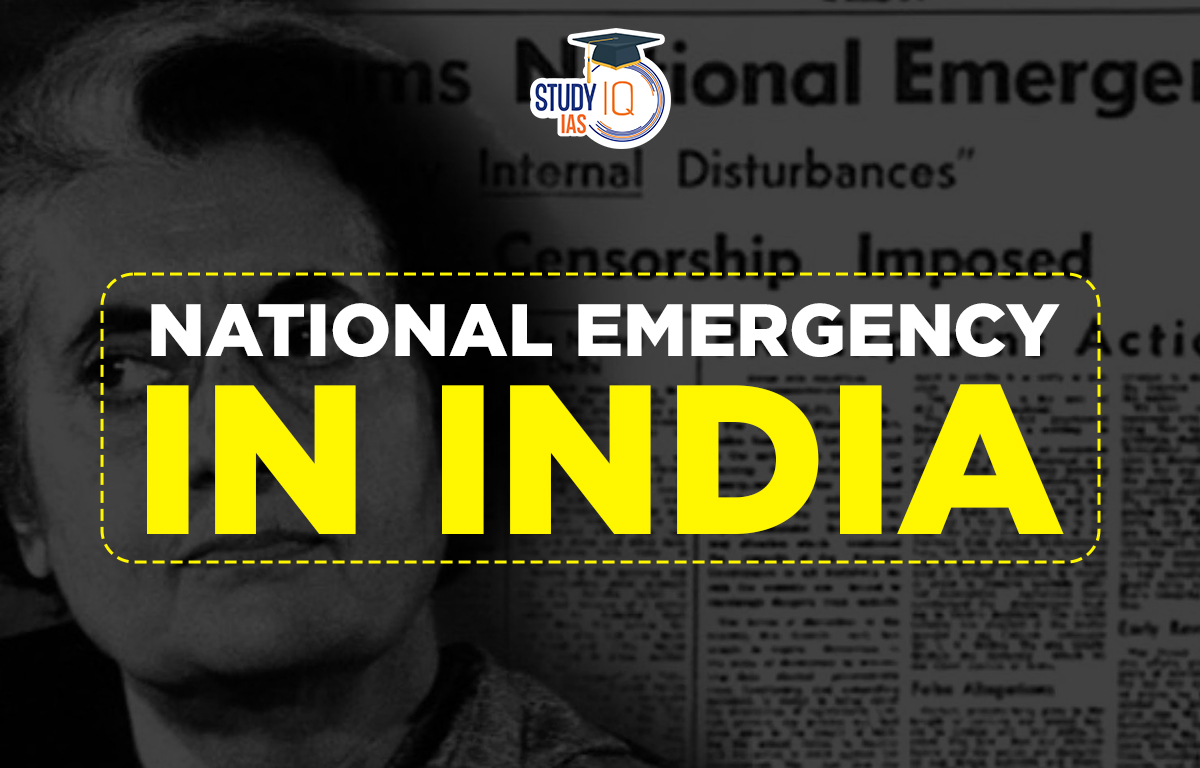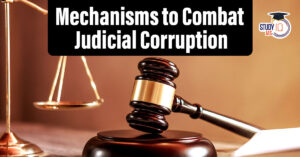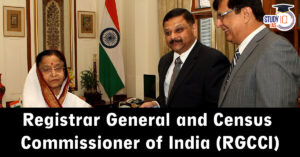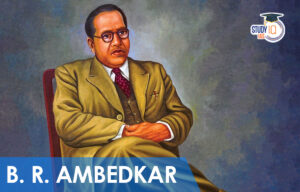Table of Contents
National Emergency in India
A national emergency is a circumstance in which the citizens’ fundamental rights are curtailed, along with a number of additional liberties. The Indian Constitution’s Article 352 governs the national emergency. According to Article 352 (part 18) of the Indian Constitution, the president may declare a national emergency if he thinks a serious situation exists in which war, an external invasion, or an armed uprising threatens the security of India or any part of its territory. India may be affected by this crisis nationwide or only in some areas.
List of Prime Minister of India
National Emergency in India Grounds of Declaration
According to Article 352, the president may declare an emergency if he or she determines that there is a serious situation in which war, foreign aggression, or armed rebellion pose a threat to the nation’s security. The entire country of India, or any section of it, may be proclaimed to be in a state of emergency. If the president determines that there is an imminent threat of war, external attack, or armed insurrection, he may declare a national emergency.
Only with the written consent of the cabinet may the president issue an emergency proclamation. The term “External Emergency” refers to a national emergency that is declared due to “war” or “external attack.” Internal emergency is the term used when a national emergency is declared due to “armed revolt.”
National Emergency in India Provision
|
Articles |
Provisions |
| Article 353 | Impact of the emergency declaration. |
| Article 354 | Application of the revenue-distribution provisions when an emergency proclamation is in effect. |
| Article 355 | Every State must be protected by the Union against external invasion and internal unrest, and every State’s government must be run in line with the requirements of this Constitution. |
| Article 357 | Exercising legislative authority under a proclamation issued in accordance with article 356. |
| Article 358 | Suspension of provisions of Article 19 during emergencies. |
| Article 359 | In times of emergency, the rights granted under Part III are not enforced. |
List of Vice Presidents of India
National Emergency in India Parliamentary Approval and Duration
The President may issue a proclamation for the entire nation or a specific region (This provision was inserted by the 42nd Constitutional Amendment Act, 1976). The proclamation will initially be in effect for one month. During this time, the cabinet must obtain parliamentary approval.
Every proclamation made pursuant to article 352 must be presented to each house of parliament for approval with the special majority, which is a majority of the total membership of that house and a majority of not less than 2/3 of the members of that house present and voting. This excludes proclamations revoking prior proclamations.
If a proclamation of this kind is not approved by parliament, it expires one month after it is proclaimed and is no longer in effect. If a proclamation of this kind is accepted by the parliament, it will remain in effect for six months starting on the day it was approved, unless it is revoked earlier.
It can be approved by the parliament as many times as necessary, but only for a total of six months at once. If the proclamation is approved by the Rajya Sabha but the Lok Sabha dissolves before doing so, the proclamation must be corrected by the Lok Sabha within 30 days of the date the Lok Sabha first convenes. According to Article 352, the president may declare an emergency, but this declaration is subject to judicial scrutiny, and its validity may be contested in court on the grounds of mala fide intents.
List of Chief Ministers of India
National Emergency in India Revocation of Proclamation
The President may, at any point during the duration of the emergency, rescind the proclamation by issuing another proclamation. The Parliament is not required to ratify such a proclamation. The 44thAmendment Act established the requirement that the President rescind if the Lok Sabha adopts a disapproval resolution by a simple majority.
If not less than one-tenth of the Lok Sabha’s members send a notification to the President asking him or her to declare an emergency even when the Lok Sabha is not in session, the emergency can be declared invalid at any time. If there isn’t a session, the LS must hold a special session within 14 days to consider such a resolution.
List of Chief Ministers of Delhi
National Emergency in India Implications
On Executive
The President of India has the authority to give instructions to the states on how to execute their executive authority. State governments are not overthrown; instead, they are brought under the effective control of the federal government, which assumes the authority to direct the state government, which is required to follow those orders (Article 353(A)).
On Legislature
According to Article 353 (B), state legislatures continue to function and pass laws, but parliament also has the authority to do so on state-related issues. A law passed by parliament that is found to be ineffective after six months will also cease to be in effect. Additionally, Article 83(2) of the Constitution allows for the extension of the Lok Sabha’s term by one year at a time. However, this extension is only permitted for a maximum of 6 months following the date the emergency was revoked.
On Financial relations
According to Article 268-279, changes to central state financial connections may be made by presidential order and approved as soon as possible by the legislature (Article 354). This adjustment, however, may never extend past the fiscal year in which the emergency is lifted. The President may halt the allocation of funds between the federal government and the states, and the federal government may utilise any available resources to combat costs if an emergency is proclaimed.
On Fundamental Rights
The suspension of the Fundamental Rights outlined in Article 19 is covered by Article 358, whereas the suspension of additional Fundamental Rights is covered by Article 359 (except those guaranteed by Articles 20 and 21). The six essential rights under Article 19 are only suspended when a national emergency is proclaimed on the grounds of war or external attack and not on the grounds of armed revolt, according to Article 358. With the exception of articles 20 and 21, Article 359 allows the president to suspend the right to petition any court for the enforcement of fundamental rights during a National Emergency.
Effect on the Life of Lok sabha and State Assembly
The Lok Sabha’s term can be prolonged for periods of one year at a time while a National Emergency is declared to be in existence. However, this extension is only valid for a maximum of six months after the emergency has passed. Similarly, during a national emergency, the Parliament may extend a state’s Legislative Assembly’s regular term by one year at a time, but only for a maximum of six months after the emergency has ended.
How many times National Emergency in India?
National Emergency in India has been declared in our country three times so far. For the first time, an emergency was declared on 26 October 1962 after China attacked our borders in the North East. This National Emergency lasted till 10 January 1968, long after the hostilities ceased.
For the second time, it was declared on 3 December 1971 in the wake of the second India- Pakistan War and was lifted on 21 March 1977. While the second emergency, on the basis of external aggression, was in operation. Third National Emergency (called internal emergency) was imposed on 25 June 1975. This emergency was declared on the grounds of ‘internal disturbances’.
List of Chief Ministers of Gujarat
National Emergency in India Criticism
- The federal character of the constitution will be gone, and the union will gain absolute power.
- The importance of fundamental rights will wane, and democracy’s foundation will be destroyed.
- The union executive will have complete control over the state’s authority, both in the Union and in the Units.
- The state’s financial independence will be taken away.
- The president will advance to become a despot..
List of Chief Ministers of Karnataka
National Emergency in India Judicial Pronouncements
The Supreme Court ruled in the Minerva Mills case (1980) that a national emergency proclamation can be contested in court on the grounds of malfeasance or that it was entirely superfluous and immaterial. In the case of Makhan Singh v. State of Punjab, the Supreme Court made a distinction between Articles 358 and 359 of the Constitution.
The Supreme Court ruled that it is a political concern and not a matter that may be litigated in the case of Bhut Nath v. State of West Bengal. Additionally, the 38th Amendment to the Constitution added clause 5 to Article 352 to clarify the stance on this topic, stating that the president’s satisfaction, as used in Article 352(1) and (3), is to mean “final and conclusive” and “could not be contested in any court of law.”
In the historic case of Kesavananda Bharati v. the State of Kerala, the Supreme Court declared that Clause 4 of Article 329A is violative and unconstitutional for the first time. By giving the legislative control over the judiciary, it goes against the separation of powers premise. It went against the “Rule of Law” to make the modification.
The 39th Constitutional Amendment Act of 1971 has been declared invalid by the Supreme Court because it goes against the fundamental principles of the Indian Constitution and is therefore unconstitutional.
|
Article 358 |
Article 359 |
| It only takes emergency action when a war or outside hostility puts the nation’s security in danger. | It functions in any emergency declared in accordance with Article 352. |
| It addresses the suspension of the Article 19-guaranteed Fundamental Rights. | The topic of the suspension of other Fundamental Rights is covered (except those guaranteed by Articles 20 and 21) |
List of Chief Ministers of Kerala
National Emergency in India FAQs
Q How many emergencies are there in India?
Ans. There are three types: the President’s Rule, the National Emergency, and the Financial Emergency (Article 356).
Q What happens when National Emergency is declared?
Ans. When an emergency is declared, the central government gains control over all concurrent issues as well as the authority to enact legislation pertaining to issues on the state list. The interaction between the federal and state governments is changed. Additionally, the citizens’ Fundamental Rights are affected.
Q What was national emergency?
Ans. Indira Gandhi, the country’s prime minister, imposed a nationwide state of emergency for 21 months between 1975 and 1977.
Q What happens in a national emergency in Australia?
Ans. A government declaration of an emergency may: Suspend some regularly scheduled government operations. Make the neighborhood aware of the issue and ask them to change their usual behavior. order the implementation of emergency preparedness strategies by government organizations.
Q What is National Emergency 10th?
Ans. When war, external aggression, or armed revolt threaten the security of India or a portion of it, the President is authorized by Article 352 to proclaim a national emergency. The 44th Amendment Act of 1978 substituted “armed rebellion” for the previous phrase “internal disturbance.”
Major Incidents in Indian History
- Quit India Movement
- Chauri Chaura Incident
- Jallianwala Bagh Massacre
- Green Revolution in India
- Non-Cooperation Movement
Famous Personalities Biography
Mangal Pandey |
Maharana Pratap |
Rabindranath Tagore |
Bhagat Singh |
Jyotiba Phule |
Satyendra Nath Bose |
Raja Ram Mohan Roy |
Subhash Chandra Bose |


 Mechanisms to Combat Judicial Corruption...
Mechanisms to Combat Judicial Corruption...
 Registrar General and Census Commissione...
Registrar General and Census Commissione...
 Ambedkar Jayanti 2025: Biography, Legacy...
Ambedkar Jayanti 2025: Biography, Legacy...





















